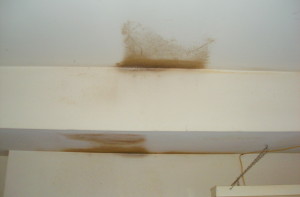
Information on Managing Moisture in Interior Surfaces in the Washington, DC/Northern Virginia Area
One of the major purposes of shelter, for any living creature, is to keep out the elements. Heat, cold, sun, wind – and, undeniably, water – need to be kept under strict control in an indoor environment if it is to remain a suitable shelter. Modern homes and buildings utilize thousands of years of complex technology in order to keep out the elements, but it is still an ongoing struggle. In this blog we share our years of contracting experience on what to do when unwanted moisture ends up inside your home.
First of all: why is interior moisture a problem? Obviously, no one wants to live in a swimming pool, or to have their furniture and belongings soggy, but moisture can also cause serious problems when present in far less dramatic quantities. Moisture undermines the structure integrity of most architectural building materials, encourages the growth of mold and mildew, and can cause paint jobs to completely fail. While exterior substrates (vinyl siding, stained decks, roofing) are designed to resist water, interior substrates are vulnerable, and will degrade rapidly in the presence of persistent moisture.
Second of all: where does interior moisture come from? If your basement or another part of your home floods, or if your roof or upstairs bathroom leaks aggressively through the ceiling, then the source of your moisture will not be a mystery. But sometimes a slow but steady leak in unexposed plumbing, a capillary effect, or even a place in your home that has a cooler microclimate, can cause subtler examples of moisture damage.
Third of all: how can you tell you have moisture damage, and what the source of the moisture is? Moisture damage will be detectable in a building because it leaves behind a stain on surfaces like drywall, paint, wood, and stucco. The shape and location of the stain will offer some clues as to what kind of moisture source you are dealing with. A round stain on a ceiling, or upside-down teardrop shaped stain on the wall, both indicate a long, slow leak, likely in the plumbing. If the stain grows more rapidly when it is raining, then the source of the water is the exterior of the house. If the stain is in a long line on the ceiling, it may come from a more diffuse leak in the plumbing. Stains from capillary action usually come up from the ground in line in a moist area, and stains from condensation are usually irregularly shaped patches near a microclimate change in the house.
Finally: what do you do about moisture damage? Because moisture damage is associated with both structural and health threats, it is essential to fix water damage as soon as the problem is observed. The steps are simple. First, locate and eliminate the source of the moisture. Second, cut out and remove all of the damaged substrate: drywall, wood, paint, and all. Finally, replace the damaged substrate with dry material, close the seams as thoroughly as possible, and repaint or refinish the patched area (as well as some of the surroundings, if you are concerned with the patched area sticking out).
Blue Door Painters is proud to offer water damage remediation as one of our services in the Washington, DC, and Northern Virginia area.